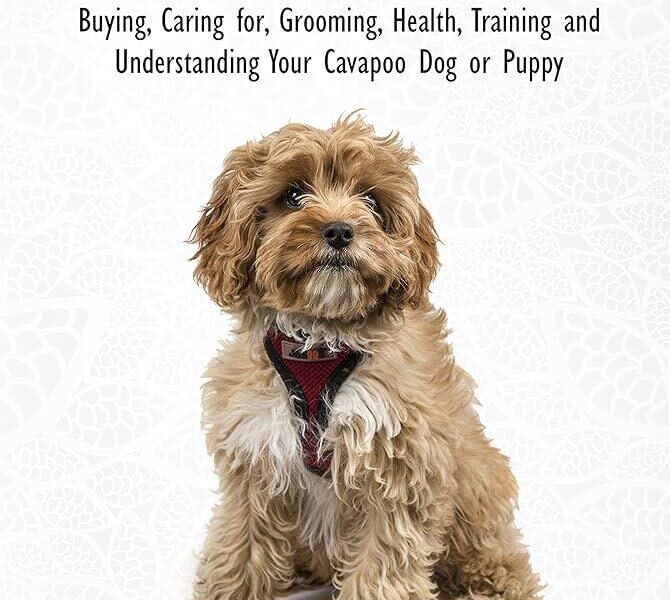Unlocking the Secrets of Cavapoo Training: Your Guide to a Happy, Well-Behaved Companion
In a world filled with delightful dog breeds, the Cavapoo stands out as a charming blend of intelligence and affection. A hybrid of the Cavalier King Charles Spaniel and the Poodle, this pint-sized pooch boasts an endearing personality that captures hearts at first glance. Yet beneath their fluffy exteriors lies a unique set of training needs that can be as varied as their curly coats. This article serves as your comprehensive guide to Cavapoo training, exploring the essential techniques and insights required to nurture a well-mannered companion. Whether you’re a first-time dog owner or a seasoned trainer, understanding the nuances of this breed will set the stage for a successful and rewarding training journey. Join us as we delve into the world of Cavapoo training, where patience, consistency, and a sprinkle of fun are key ingredients for a harmonious relationship with your furry friend.
Table of Contents
- Understanding the Unique Personality Traits of Cavapoos
- Essential Training Techniques to Nurture Intelligent Canine Companions
- Socialization Strategies for a Well-Adjusted Cavapoo
- Addressing Common Behavioral Challenges in Cavapoo Training
- Q&A
- Wrapping Up
Understanding the Unique Personality Traits of Cavapoos
Cavapoos are a delightful mix of Cavalier King Charles Spaniel and Poodle, inheriting distinct traits from both parent breeds. This hybrid often exhibits a friendly and affectionate nature, making them excellent companions. Their temperament is generally characterized by a balance of playfulness and calmness, allowing them to fit seamlessly into various households, whether bustling or serene. During training, you’ll likely notice their curiosity and intelligence—traits that can make learning new commands both engaging and rewarding. However, it’s crucial to remember that consistent and positive reinforcement methods tend to work best, as these dogs thrive on love and encouragement.
Equipped with a strong desire to please their owners, Cavapoos tend to display exceptional loyalty and companionship. Many share a few common personality traits, including:
- Affectionate: These dogs love to cuddle and are often found snuggling with family members.
- Social: Cavapoos often enjoy the company of other pets and people, making them ideal for social households.
- Adaptable: Whether you live in a large home or a cozy apartment, Cavapoos can adjust to different living environments easily.
- Intelligent: Their quick learning abilities make them responsive to training and trick learning.
Understanding these unique personality traits is vital for effective training and socialization. Here’s a quick overview of other key characteristics that can help in shaping your training approach:
| Trait | Impact on Training |
|---|---|
| Playfulness | Incorporate games into training sessions to keep them engaged. |
| Affectionate Nature | Use plenty of praise and physical affection as rewards. |
| Sensitivity | Be gentle and patient, as harsh training methods can backfire. |
| Curiosity | Expose them to new experiences to stimulate their minds. |
Essential Training Techniques to Nurture Intelligent Canine Companions
Training your Cavapoo can be a delightful journey, as their eagerness to please makes them quick learners. To cultivate well-rounded and intelligent companions, focus on positive reinforcement techniques that enhance trust and engagement. Consider incorporating the following practices into your training routine:
- Consistency: Use the same commands and cues to prevent confusion.
- Short sessions: Keep training sessions to around 5-10 minutes to maintain their attention.
- Praise and rewards: Celebrate achievements with treats, toys, or friendly praise to motivate your Cavapoo.
- Socialization: Introduce them to new environments and people to develop confidence and adaptability.
Monitoring progress is crucial for ensuring effective training. Maintain an organized chart to track your Cavapoo’s achievements and areas needing improvement. This not only helps you stay on top of training goals but also provides insight into your pup’s individual learning pace. Here’s a simple table structure to visualize key training milestones:
| Milestone | Status | Date Achieved |
|---|---|---|
| Basic Commands (Sit, Stay) | ✔️ Achieved | MM/DD/YYYY |
| Leash Training | ✔️ In Progress | MM/DD/YYYY |
| House Training | ✔️ Needs Attention | MM/DD/YYYY |
Socialization Strategies for a Well-Adjusted Cavapoo
One of the key elements to ensure your Cavapoo grows into a well-adjusted companion is effective socialization. Start the process early, introducing your furry friend to a variety of environments, people, and other pets. This will help them become more adaptable and confident in diverse situations. Consider engaging in activities like:
- Play Dates: Arrange regular meet-ups with other friendly dogs.
- Group Classes: Enroll in puppy kindergarten or obedience classes to foster good behavior.
- Outings: Take your Cavapoo on trips to the park or pet-friendly events to expose them to new sights and sounds.
Positive reinforcement is essential during this process. When your Cavapoo exhibits friendly behavior or interacts well with others, reward them with treats or words of praise. Consistency along with a structured approach will help solidify these social skills. To monitor your progress, keep a record in the following table:
| Date | Activity | Observation |
|---|---|---|
| 10/01 | Park Visit | Played well with other dogs. |
| 10/05 | Puppy Class | Observed new commands easily. |
| 10/10 | Friend’s House | Approached strangers confidently. |
Addressing Common Behavioral Challenges in Cavapoo Training
Training a Cavapoo can be a delightful yet challenging experience, especially when dealing with common behavioral issues. One of the most frequent challenges is their tendency to become easily distracted. Given their affectionate and sociable nature, Cavapoos can lose focus in stimulating environments, making training sessions difficult. To combat distractions, try the following techniques:
- Short Training Sessions: Keep training sessions brief (5-10 minutes) to maintain their interest and concentration.
- Quiet Environment: Begin training in a distraction-free space until they grasp the commands.
- High-Value Rewards: Use special treats or toys that your pet loves to motivate them to pay attention.
Another behavioral challenge is their tendency to be a bit stubborn at times, which can lead to resistance during training. To address this, it’s crucial to remain calm and patient, ensuring you do not push them too hard. Consistency is key, so implementing a routine will help. Consider the following strategies:
| Strategy | Description |
|---|---|
| Positive Reinforcement | Reward desired behaviors with treats or praise to encourage repetition. |
| Clear Commands | Use simple, distinct commands consistently, so your Cavapoo understands expectations. |
| Frequent Breaks | Allow for short breaks to let them relax and reset their focus. |
Q&A
Q&A: Training Your Cavapoo – A Comprehensive Guide
Q1: What is a Cavapoo, and why is training important for this breed?
A: A Cavapoo is a delightful crossbreed between a Cavalier King Charles Spaniel and a Poodle. Known for their friendly demeanor and intelligence, Cavapoos thrive on companionship and mental stimulation. Training is crucial not only for teaching obedience but also for fostering a strong bond between you and your furry friend. Proper training helps to curb potential behavioral issues and ensures a well-adjusted pet that fits seamlessly into your family.
Q2: At what age should I start training my Cavapoo?
A: The sooner, the better! You can begin basic training as early as eight weeks old. Young Cavapoos are like sponges, eager to soak up knowledge. Focus on foundational commands such as “sit,” “stay,” and “come.” Early socialization with different environments, people, and other animals is equally important to help your Cavapoo grow into a confident and well-mannered adult.
Q3: What training methods work best for Cavapoos?
A: Cavapoos respond well to positive reinforcement techniques. This involves rewarding good behavior with treats, praise, or playtime. Avoid harsh training methods, as they can lead to fear and anxiety. Keep training sessions short and engaging, ideally around 5 to 10 minutes, to match their attention span. Combining fun activities, like games or tricks, with proper training can make the learning process enjoyable for both you and your Cavapoo.
Q4: How can I address common behavioral issues in my Cavapoo?
A: Common issues such as barking, chewing, or pulling on the leash can be effectively addressed through consistent training and routine. For excessive barking, teach the “quiet” command using treats to reinforce silence. Chewing can be minimized by providing plenty of toys and engaging activities. For leash pulling, practice loose-leash walking techniques, rewarding your Cavapoo for staying by your side. Patience and consistency are key to overcoming these challenges.
Q5: How social should my Cavapoo be?
A: Socialization is vital for Cavapoos to develop into well-rounded dogs. Gradually expose your pup to varied environments, such as parks, pet-friendly stores, and gatherings. Introduce them to other dogs and people to promote confidence. Positive experiences will help your Cavapoo become more adaptable and friendly, which can prevent behavioral issues stemming from fear or anxiety.
Q6: Should I consider professional training for my Cavapoo?
A: If you feel overwhelmed or if your Cavapoo exhibits challenging behaviors, seeking professional help can be beneficial. Group classes or one-on-one sessions with a certified trainer can offer personalized guidance and socialization opportunities. These classes can also help reinforce your training efforts at home, ensuring a cohesive approach to your Cavapoo’s education.
Q7: How do I maintain continued training as my Cavapoo matures?
A: Training doesn’t stop after the puppy phase; it’s a lifelong journey! Keep the training engaging by introducing new commands or tricks. Incorporate training into daily routines, like practicing commands during walks, mealtimes, or play sessions. Regular mental stimulation is essential, so consider puzzle toys or interactive games to challenge your Cavapoo’s intellect as they mature.
Q8: Any final tips for training my Cavapoo?
A: Absolutely! Stay patient, positive, and persistent. Celebrate small victories and remember that every pup learns at their own pace. Creating a strong bond during training sessions will help your Cavapoo trust you and feel secure. Lastly, enjoy the journey—training should be a fun and rewarding experience for both of you!
—
With the right approach to training, your Cavapoo will not only gain essential skills but also thrive as a cherished family member. Happy training!
Wrapping Up
As we conclude our journey through the world of Cavapoo training, it’s evident that nurturing this delightful blend of Cavalier King Charles Spaniel and Poodle requires patience, consistency, and a sprinkle of creativity. These charming companions thrive on positive reinforcement and engagement, making training a rewarding adventure for both pet and owner. Remember, every Cavapoo is unique, and embracing their individual personalities will unlock their full potential. Armed with the insights shared in this article, you are now well-equipped to embark on a fulfilling training experience that enhances your bond with your furry friend. May your days together be filled with joy, learning, and countless wagging tails!


